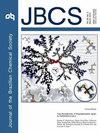Synthesis of Polycardanol Using BF3.O(C2H5)2 as Initiator: Influence of Polymerization Conditions on Reaction Products
IF 1.3
4区 化学
Q3 CHEMISTRY, MULTIDISCIPLINARY
引用次数: 1
Abstract
Cardanol acts to stabilize asphaltene particles in crude oil, but its derivative polycardanol, synthesized with BF3.O(C2H5)2 as initiator, exhibits divergent behavior, acting as both asphaltenes stabilizer and flocculant. This behavior could be related to structural differences in polycardanol samples. Therefore, in this work, we study the influence of some polymerization conditions (monomer purity, initiator concentration, and reaction time) on the structures and molar masses of the reaction products, and the reaction conversion. The materials were characterized by size‑exclusion chromatography and hydrogen and carbon nuclear magnetic resonance. When reacting with distilled cardanol, the conversion, the molar mass, and the homogeneity of structures increased as increasing initiator concentration in the range tested (1-3% m/m). For both monomers (different purity degrees), when using a lower initiator concentration (1% m/m), the product contained a larger amount of unreacted monomer and different structures were obtained due to the occurrence of rearrangements. The presence of triolefinic molecules in the monomer provoked crosslinked structures for higher initiator concentration (2-3% m/m). This study elucidated the differences among the reaction products of polycardanol.以BF3.O(C2H5)2为引发剂合成聚腰果酚:聚合条件对反应产物的影响
腰果酚具有稳定原油中沥青质颗粒的作用,但其衍生物聚腰果酚以BF3.O(C2H5)2为引发剂合成后,表现出分散性,既是沥青质稳定剂,又是絮凝剂。这种行为可能与聚腰果酚样品的结构差异有关。因此,在本工作中,我们研究了一些聚合条件(单体纯度、引发剂浓度和反应时间)对反应产物的结构和摩尔质量以及反应转化率的影响。采用粒径排除色谱法和氢碳核磁共振对材料进行了表征。当与蒸馏腰果酚反应时,在测试范围内(1-3% m/m),随着引发剂浓度的增加,转化率、摩尔质量和结构均匀性都有所增加。对于两种不同纯度的单体,当使用较低的引发剂浓度(1% m/m)时,产物中未反应单体的含量较大,并且由于重排的发生而得到不同的结构。在较高的引发剂浓度(2-3% m/m)下,单体中三烯烃分子的存在引发了交联结构。本研究阐明了聚腰果酚不同反应产物的差异。
本文章由计算机程序翻译,如有差异,请以英文原文为准。
求助全文
约1分钟内获得全文
求助全文
来源期刊
CiteScore
2.90
自引率
7.10%
发文量
99
审稿时长
3.4 months
期刊介绍:
The Journal of the Brazilian Chemical Society embraces all aspects of chemistry except education, philosophy and history of chemistry. It is a medium for reporting selected original and significant contributions to new chemical knowledge.

 求助内容:
求助内容: 应助结果提醒方式:
应助结果提醒方式:


